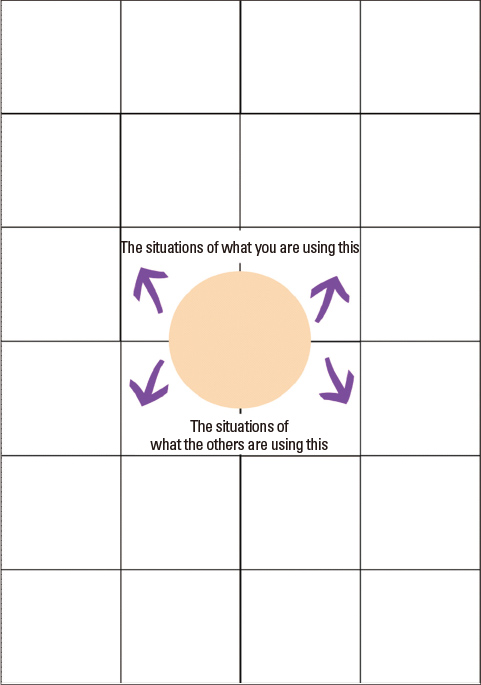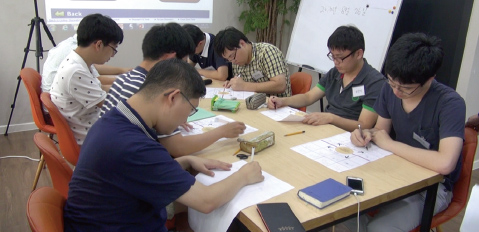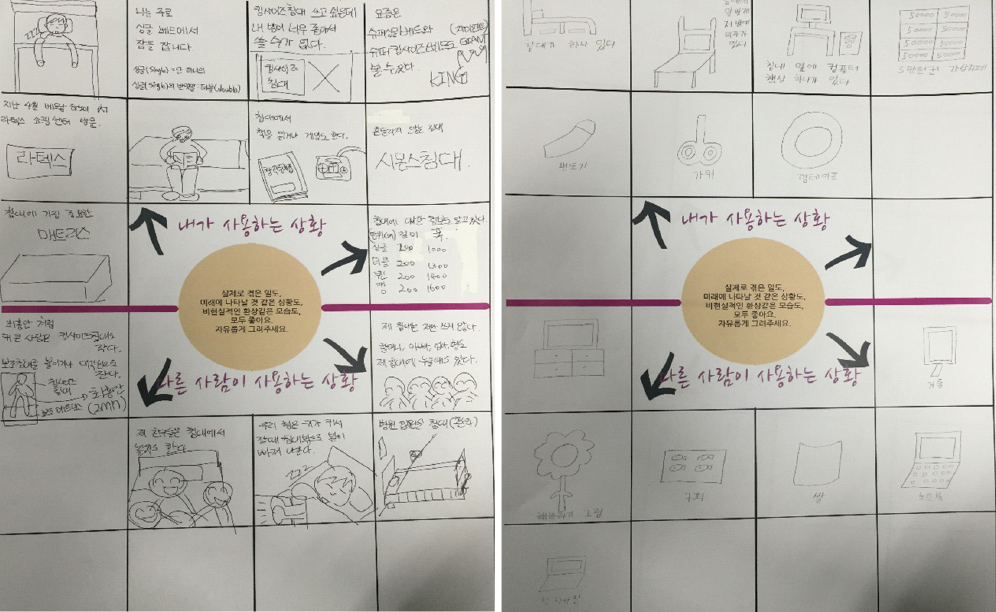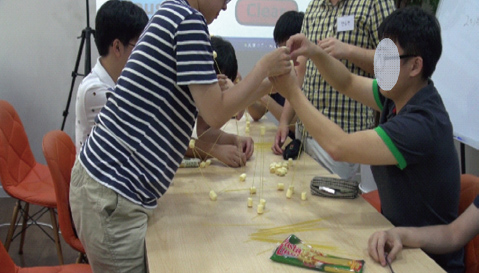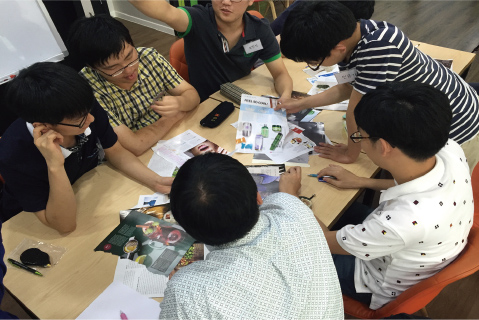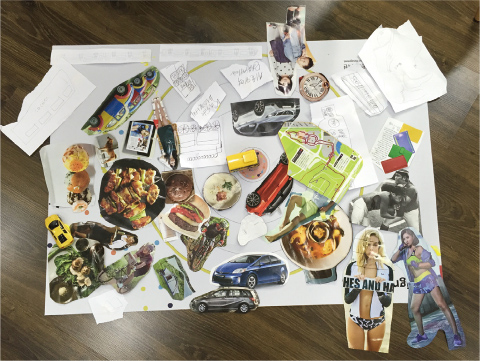Hanyang Med Rev.
2016 Feb;36(1):11-16. 10.7599/hmr.2016.36.1.11.
A Design Thinking Process with 'Aspie': Developing a New Intervention for People with Asperger's Syndrome
- Affiliations
-
- 1Imagine Lab, Hanyang University, Seoul, Korea. hokyoung.ryu@gmail.com
- KMID: 2168367
- DOI: http://doi.org/10.7599/hmr.2016.36.1.11
Abstract
- People with Asperger's syndrome (AS) have a rather different thinking style. They may create new ideas that the designer can see this awkward thinking style as the driver for developing new and innovative ideas. In this paper, both 'Aspie' and the designer work together to make innovative ideas, by which 'Aspie' could find a new contributive role in communal living. An ideation workshop is composed of two different stages with several ideation methods. Described is an observational study of how the ideation workshop covers their deficits and makes them adapt to generate their different ideas. From the observation, this paper realizes how we start to reestablish the relationship between AS people and the society.
MeSH Terms
Figure
Cited by 1 articles
-
Introduction: Neurodevelopmental Disorders
Dong Hyun Ahn
Hanyang Med Rev. 2016;36(1):1-3. doi: 10.7599/hmr.2016.36.1.1.
Reference
-
1. Asperger H. Die "Autistischen Psychopathen" im Kindesalter. Eur Arch Psychiatry Clin Neurosci. 1944; 117:76–136.
Article2. Church C, Alisanski S, Amanullah S. The social, behavioral, and academic experiences of children with Asperger syndrome. Focus Autism Other Dev Disabl. 2000; 15:12–20.
Article3. Kaufman C. Asperger syndrome: implications for educators. Brown Univ Child Adolesc Behav Lett. 2002; 18:1–3.
Article4. Klin A, Saulnier C, Tsatsanis K, Volkmar FR. Clinical evaluation in autism spectrum disorders: psychological assessment within a transdisciplinary framework. In : Volkmar FR, Paul R, Klin A, Cohen D, editors. Handbook of autism and pervasive developmental disorders. 3th ed. Hoboken: John Wiley & Sons;2005. p. 772–798.5. Attwood T. The complete guide to Asperger's syndrome. London: Jessica Kingsley Publishers;2006.6. Gutstein SE, Whitney T. Asperger syndrome and the development of social competence. Focus Autism Other Dev Disabl. 2002; 17:161–171.
Article7. Neihart M. Gifted children with Aspergers' syndrome. Gifted Child Q. 2000; 44:222–230.
Article8. Wing L. The continuum of autistic characteristics. In : Schopler E, Mesibov GB, editors. Diagnosis and assessment in autism. New York (NY): Plenum Press;1988. p. 91–110.9. Andari E, Duhamel JR, Zalla T, Herbrecht E, Leboyer M, Sirigu A. Promoting social behavior with oxytocin in high-functioning autism spectrum disorders. Proc Natl Acad Sci U S A. 2010; 107:4389–4394.
Article10. Grandin T. How does visual thinking work in the mind of a person with autism? A personal account. Philos Trans R Soc Lond B Biol Sci. 2009; 364:1437–1442.
Article11. Grandin T, Johnson C. Animals in translation: using the mysteries of autism to decode animal behavior. New York (NY): SUNY Press;2009.12. Gillberg C, Gillberg C, Råstam M, Wentz E. The Asperger Syndrome (and high-functioning autism) Diagnostic Interview (ASDI): a preliminary study of a new structured clinical interview. Autism. 2001; 5:57–66.
Article13. Moreno DP, Yang MC, Hernández AA, Linsey JS, Wood KL. A step beyond to overcome design fixation: a design-by-analogy approach. In : Gero JS, Hanna S, editors. Design Computing and Cognition'14. London: Springer;2015. p. 607–624.14. Toh CA, Miller SR, Kremer GEO. The impact of product dissection activities on the novelty of design outcomes. In : Proceedings of the ASME International Design Engineering Technical Conferences and Computers and Information in Engineering Conference; 2012 Aug 12-Aug 15; Chicago (IL), USA. American Society of Mechanical Engineers;2012. p. 615–624.15. Tseng I, Moss J, Cagan J, Kotovsky K. Overcoming blocks in conceptual design: the effects of open goals and analogical similarity on idea generation. In : Proceedings of the ASME 2008 International Design Engineering Technical Conferences and Computers and Information in Engineering Conference; 2008 Aug 3-Aug 8; New York (NY), USA. American Society of Mechanical Engineers;2008. p. 3–9.16. Adachi M, Ito E, Fujimoto T. Proposal on Divergent Web Search Engine with Mandal-Art. In : The 14th International Conference on Internet Computing (ICOMP'13); 2013 Jul 22-Jul 25; Las Vegas (NV), USA. 2008.17. Duncker K, Lees LS. On problem-solving. Psychol Monogr. 1945; 58:i.
Article18. Adamson RE. Functional fixedness as related to problem solving: a repetition of three experiments. J Exp Psychol. 1952; 44:288.
Article19. Agogué M, Kazakçi A, Weil B, Cassotti M. The impact of examples on creative design: explaining fixation and stimulation effects. In : DS 68-2: Proceedings of the 18th International Conference on Engineering Design (ICED 11), Impacting Society through Engineering Design, Vol 2: Design Theory and Research Methodology; 2011 Aug 15-Aug 19; Lyngby/Copenhagen, Denmark. The Design Society;2011.20. Bouchard C, Christofol H, Roussel B, Aoussat A. Identification and integration of product design trends. In : Proceeding of the 12th International Conference on Engineering Design; Munich, Germany. Technische Universität;1999.21. Bouchard C, Kim J, OMHOVER J-F, AOUSSAT A. Cognitive designers activity study, formalization, modelling, and computation. CIRP J Manuf Sci Technol. 2010; 3:218–226.
- Full Text Links
- Actions
-
Cited
- CITED
-
- Close
- Share
- Similar articles
-
- A Study of the Validity of and Cut-Off Scores for the Korean Version of Asperger Syndrome Diagnostic Scale
- Instructional Design for Systems Thinking Education in Health Systems Science
- Development of a Medical Humanities Course Based on Design Thinking and Medical Students’ Perceptions
- The Effects of PBL (Problem-Based Learning) on the Self-Directed Learning, Critical Thinking Disposition, and Problem Solving Process of Nursing Students
- The Effects of PBL(Problem-Based Learning) on the Metacognition, Critical Thinking, and Problem Solving Process of Nursing Students


